There’s large uncertainty about what insurance policies the federal authorities will change that can have an effect on electrical automobile (EV) manufacturing and gross sales within the US. However there is no such thing as a query concerning the impression that EVs can have on lowering climate-changing emissions. Changing gasoline with electrical energy significantly reduces the carbon emissions from driving, even when emissions from mining, manufacturing, and producing electrical energy are included. Primarily based on the place EVs have been bought, driving the typical electrical automobile within the US produces international warming emissions equal to a hypothetical 100 mile per gallon gasoline automobile, or one fourth the emissions from driving the common new gasoline automobile.
Transportation is the largest sector for emissions and passenger vehicles, vans, and SUVs are nearly all of emissions from this sector, so there is no such thing as a option to decelerate local weather change and not using a basic shift from petroleum to scrub electrical energy to energy our automobiles.
Driving the typical EV within the US produces carbon dioxide emissions equal to a hypothetical 100 mpg gasoline automobile.
When UCS first in contrast driving an EV to a gasoline automobile, solely 45 p.c of the nation lived the place driving an EV had decrease climate-changing emissions than a 50 MPG gasoline automobile. Now, 97 p.c of the nation lives the place the common EV is healthier than the best gasoline automobile (57 mpg). And for everybody within the US, driving probably the most environment friendly EV produces much less international warming emissions than any gasoline-only automobile obtainable (together with non-plug-in hybrids).
These outcomes are primarily based on the latest electrical energy emissions knowledge obtainable from the US EPA. Launched earlier this yr, the information displays precise powerplant emissions for 2023. As our electrical energy grid switches to extra renewable sources of electrical energy, the local weather advantages of switching from gasoline to electrical energy will proceed to develop.
EV emissions rely on supply of electrical energy
The emissions from driving an EV will depend on the place the electrical energy comes from to recharge it, and that will depend on the place within the nation you’re recharging. In locations with a comparatively clear grid, emissions from driving an EV are very low. For instance, driving an EV in upstate NY is the same as a 354 mpg gasoline automobile, or lower than 7 p.c of the typical new gasoline automobile emissions.
Even the place the grid nonetheless has vital fossil fuel-powered technology, EVs are a cleaner alternative. Within the grid area that serves most of Texas, driving the typical EV produces emissions equal to an 83 mpg gasoline automobile, regardless of over 60% of electrical energy technology coming from fossil fuels.
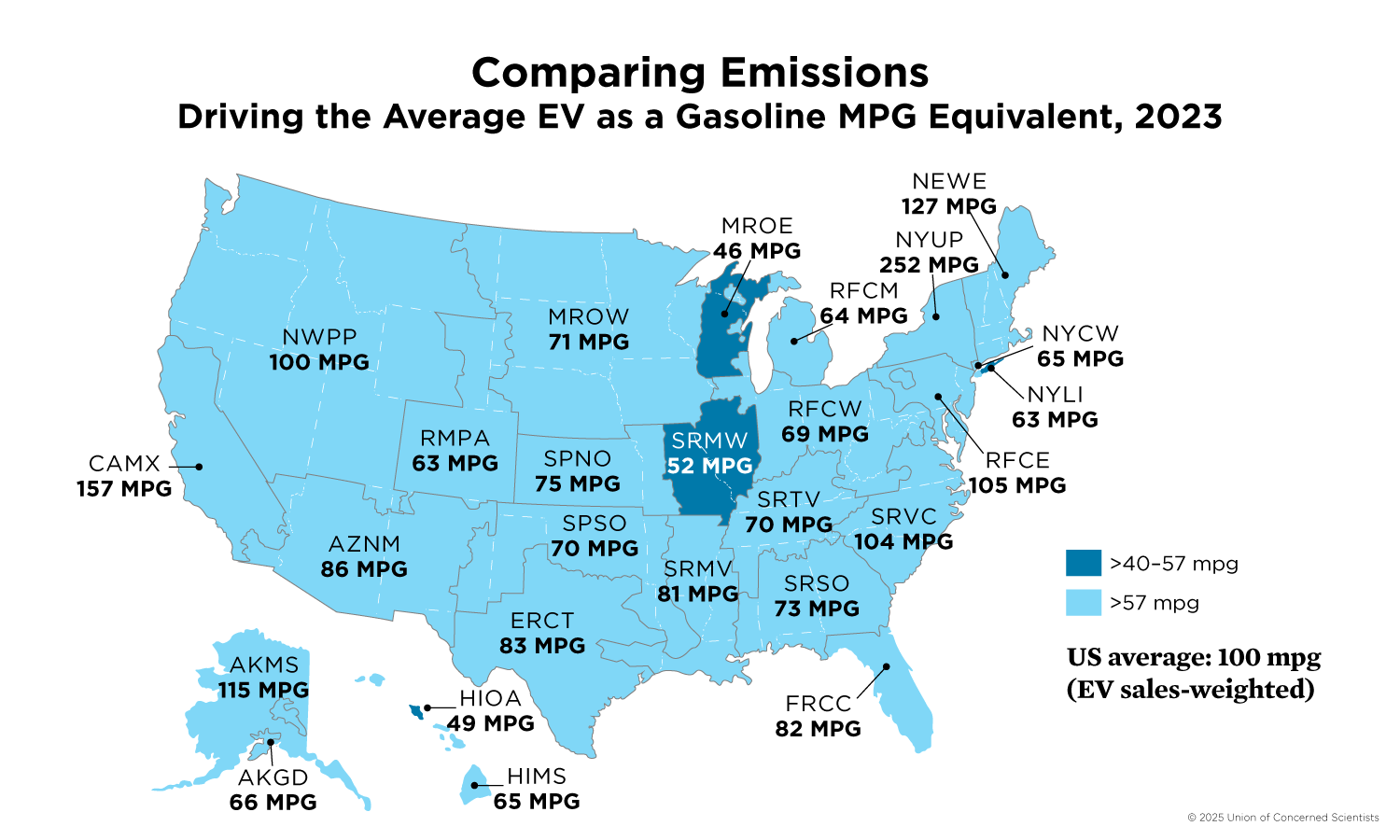
EVs are chargeable for lower than half the worldwide warming air pollution of gasoline vehicles, even when together with emissions from manufacturing
Manufacturing an EV ends in extra international warming emissions than manufacturing a comparable gasoline automobile. That is mainly because of the power and supplies required to provide an EV’s battery. Nevertheless, many of the international warming emissions over the lifespan of in the present day’s automobiles happen throughout use, so the reductions from driving an EV greater than offset the upper manufacturing emissions. When evaluating the typical gasoline automobile and 2-wheel drive SUV (29 mpg) to the average-efficiency EV with a 300-mile-range battery, the EV reduces whole lifetime emissions 58 p.c, and an EV pickup truck reduces lifetime emissions 57 p.c in contrast with the typical gasoline pickup.
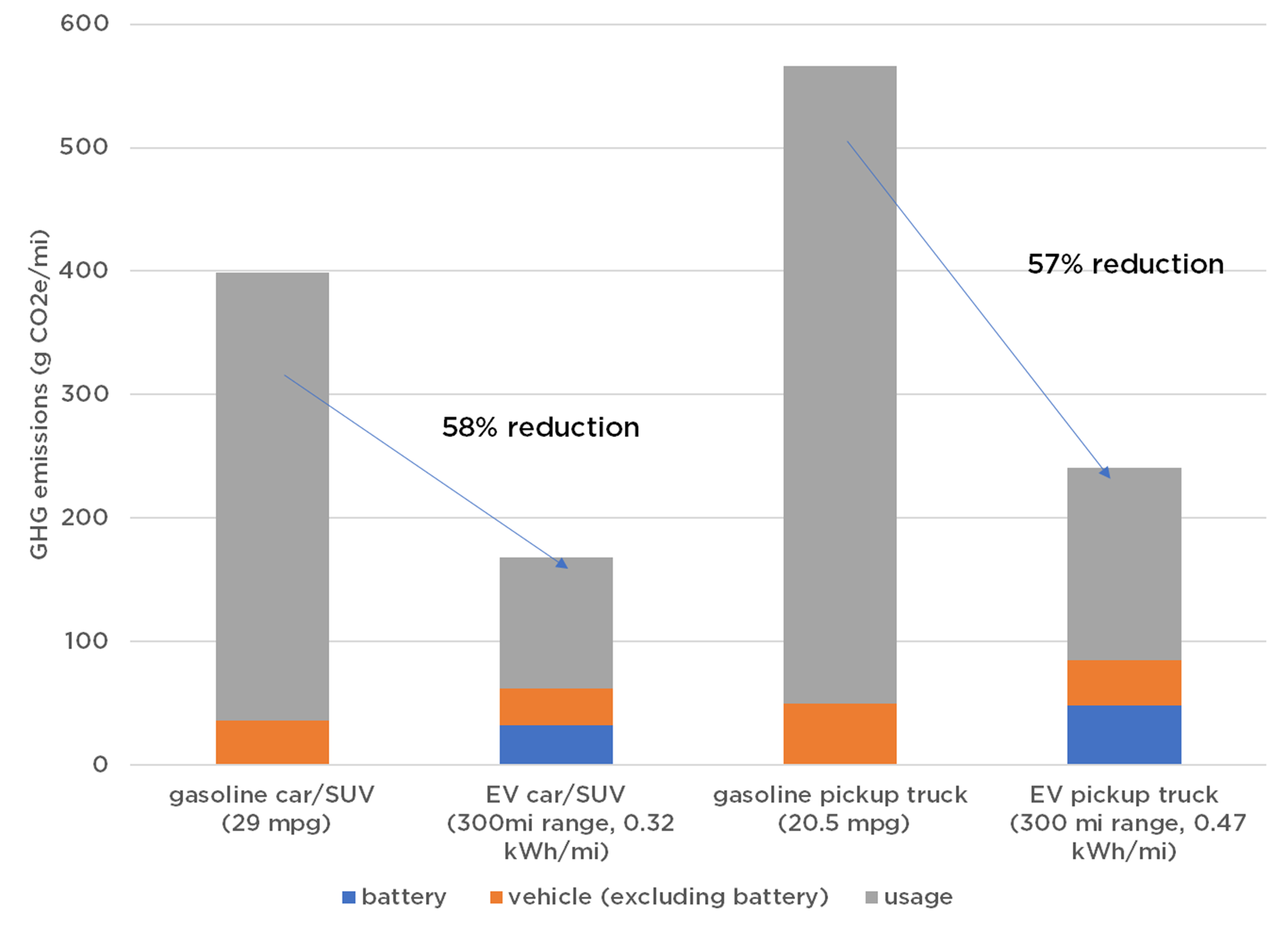
One other option to perceive how emissions financial savings from driving an EV offset extra manufacturing emissions is to contemplate the breakeven level: how far or how lengthy an EV must drive for the financial savings to match the preliminary emissions “debt.” Primarily based on the typical electrical energy emissions for recharging EVs bought within the US, the breakeven level for an electrical automobile with a 300-mile vary in contrast with the typical new gasoline automobile is about 18,000 miles of driving or lower than 2 years, primarily based on common annual driving. Breakeven happens extra rapidly, after about 17,700 miles, when evaluating an electrical truck with a 300-mile vary with the typical new gasoline pickup truck.
For each vehicles and pickups, internet financial savings come early in an EV’s lifetime, and most EVs would yield vital internet emissions financial savings. After 150,000 miles of driving, the typical EV automobile would end in 34 metric tons of prevented carbon dioxide emissions and the typical EV pickup truck in 48 metric tons, in comparison with manufacturing and driving a comparable gasoline automobile.
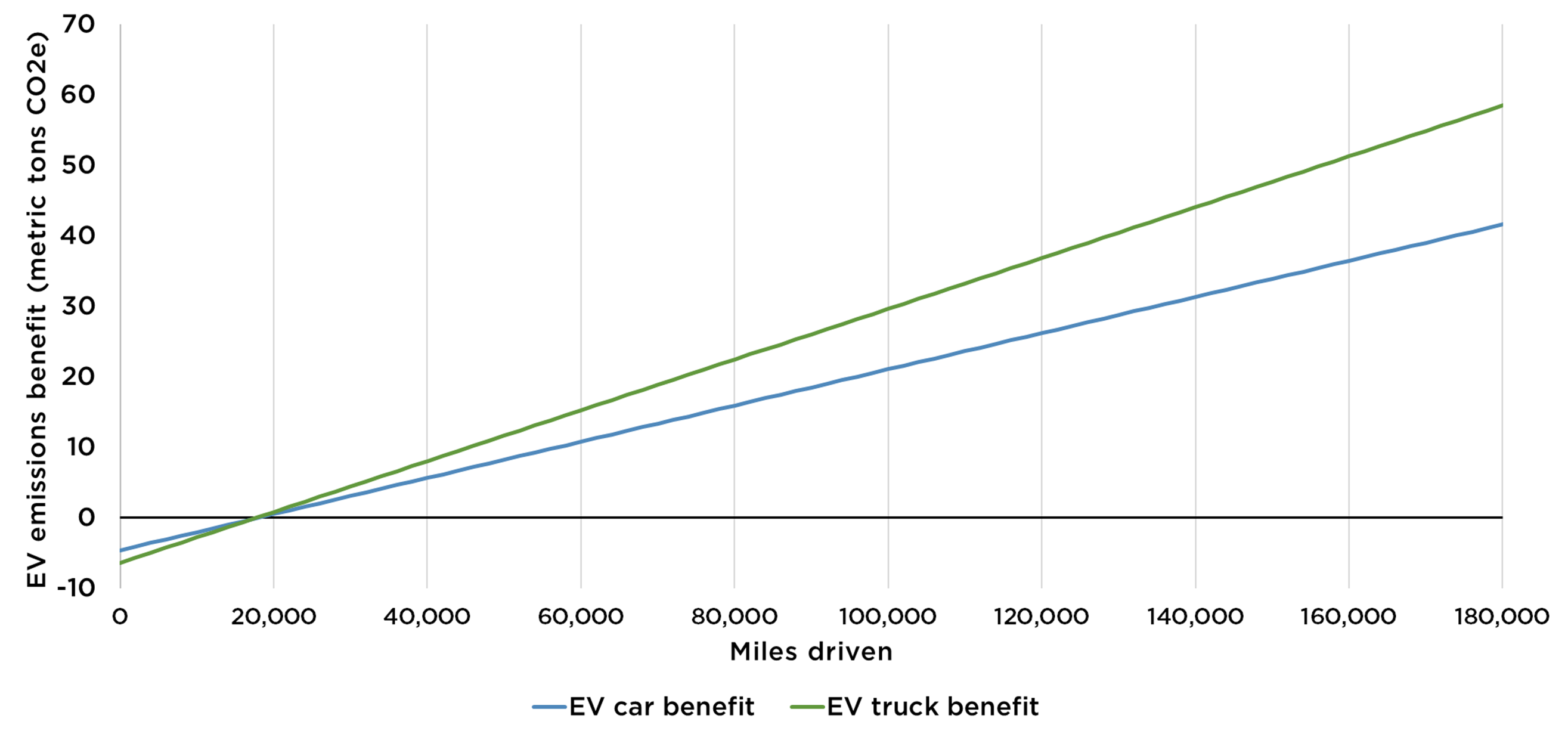
Selecting a extra environment friendly EV can offset charging on dirtier energy
EVs fluctuate in effectivity, with probably the most environment friendly EVs going greater than 4 miles on one kilowatt-hour of electrical energy whereas some electrical pickup vans get lower than 2 miles of driving on the identical quantity of power. Selecting a extra environment friendly EV that meets your driving wants will cut back the emissions from driving. For instance, charging the typical EV on Florida’s grid means efficient emissions equal to 82 mpg in a gasoline automobile, whereas selecting an EV just like the Lucid Air can cut back emissions to that of a 115 mpg standard automobile. And naturally, a extra environment friendly EV will even price much less to recharge.
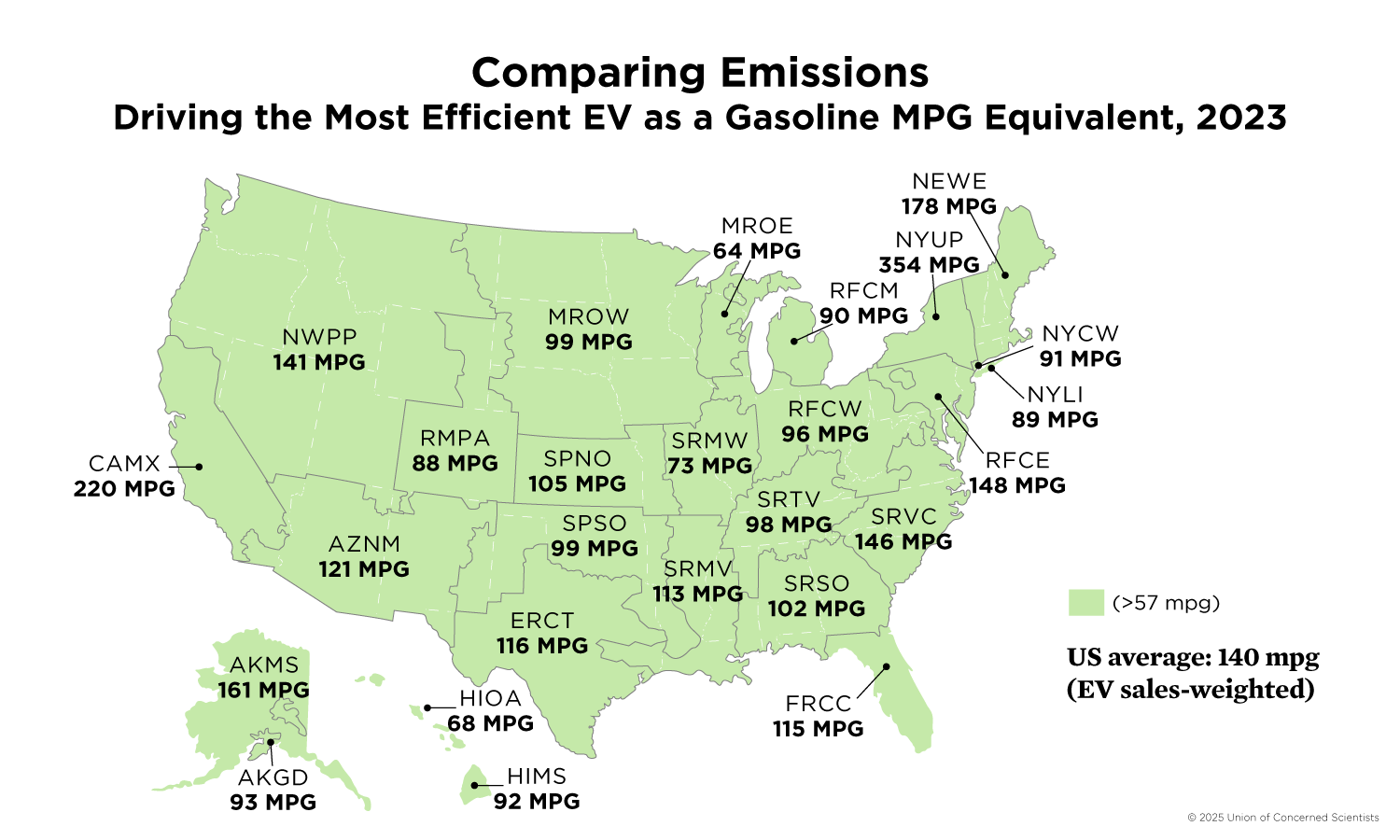
Electrifying bigger automobiles like pickups may also cut back emissions
Utilizing an electrical pickup truck within the place of a gasoline truck can have clear emissions advantages; on the grid that covers most of Texas, utilizing a mean electrical pickup truck can have emissions decrease than a 2025 Toyota Prius XLE (52 mpg). Nevertheless, switching from an environment friendly gasoline automobile to an electrical truck means lowering or eliminating the local weather advantage of electrification. Drivers that want to decrease their emissions and gasoline invoice ought to select electrical automobiles over gasoline automobiles but additionally select probably the most environment friendly automobile that meets their transportation wants.
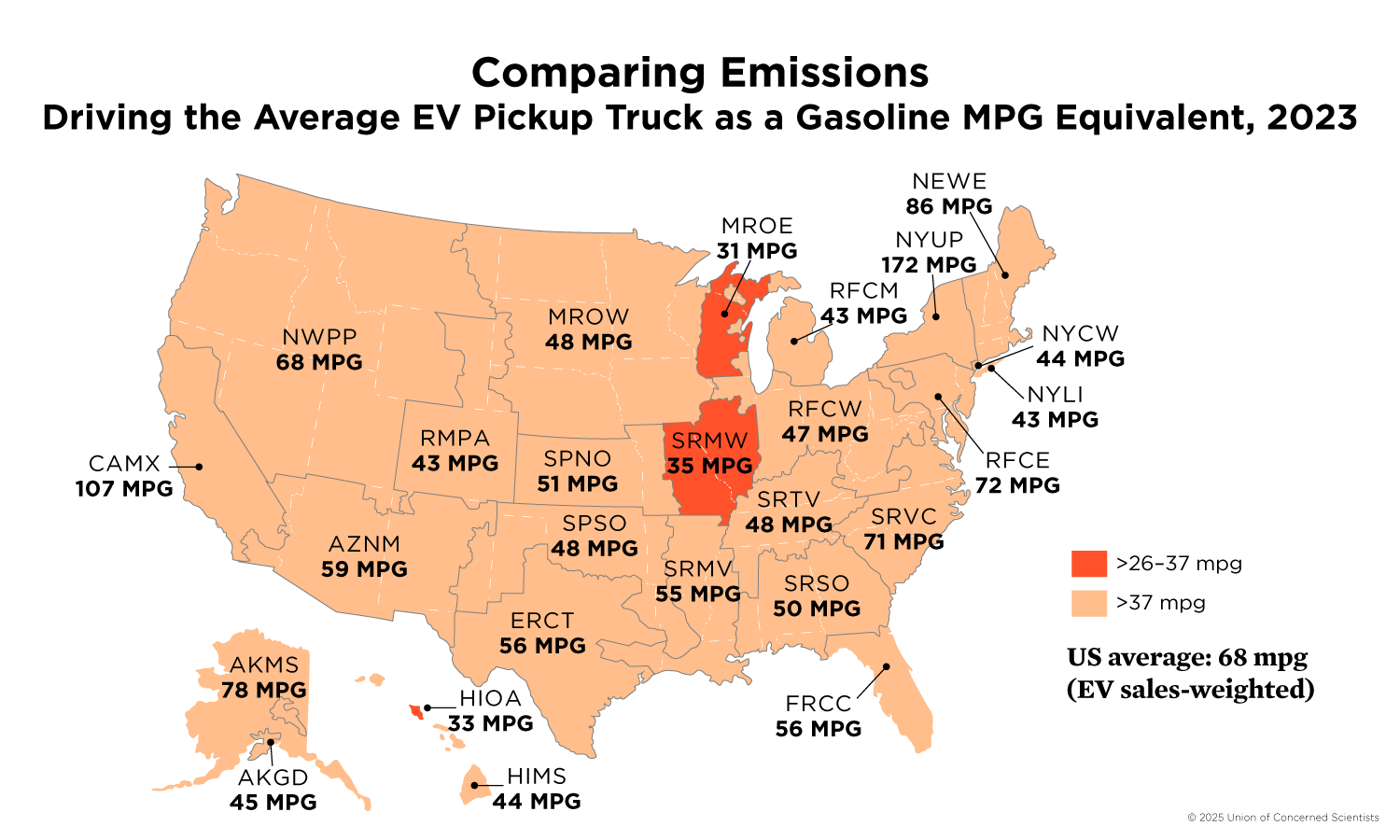
Emissions from electrical energy technology (and for utilizing EVs) have dropped dramatically
The first UCS evaluation of the emissions from EV driving in 2012 confirmed promise for EVs, however the emissions for some components of the nation have been equal to the environment friendly non-hybrid gasoline vehicles of the time. Within the 2012 evaluation, solely 45% of the nation lived the place driving an EV was higher than a 50 MPG gasoline automobile. On this most up-to-date evaluation, that quantity has skyrocketed to 97% of the nation residing the place the common EV is healthier than the best gasoline automobile (57 mpg). And for everybody within the US, driving probably the most environment friendly EV produces much less international warming emissions than any gasoline-only automobile obtainable (together with non-plug-in hybrids).
Driving on electrical energy is healthier, for journeys that require a automobile
Switching from gasoline to electrical energy means vital reductions in climate-changing emissions and this transition is a obligatory step to keep away from the worst impacts of local weather change. However the emissions financial savings from not driving altogether are even larger. Changing driving with public transit or e-bikes can significantly cut back emissions. And strolling or utilizing a standard bike means avoiding air air pollution and climate-changing emissions altogether. With our present transportation system, it’s tough for many individuals to modify all their journeys to transit, strolling, or biking, however utilizing these modes even a part of the time could make a constructive distinction within the air pollution from private transportation.
Notes on calculations
The evaluation introduced on this weblog makes use of the strategies detailed within the 2022 report “Driving Cleaner”, with the next modifications:
- The info supply for electrical energy technology was up to date to EPA’s eGRID2023 knowledge (launched in January 2025).
- Upstream emissions components now use the GREET2024 database from Argonne Nationwide Laboratory.
- Small-scale photo voltaic (residential and business) that’s not included in eGRID has been estimated utilizing the state-level knowledge from the Power Data Company’s Electrical Energy Month-to-month (desk 1.17B) report and allotted to grid subregions utilizing population-weighted averages primarily based on EPA’s ZIP code subregion assignments.
- The typical EV effectivity and placement of EV gross sales (for the sales-weighted nationwide emissions estimate) has been up to date to replicate EV gross sales from 2015 by 2024 primarily based on knowledge from Atlas Public Coverage.
- The manufacturing emissions now use GREET2024 and replicate a 95kWh battery for automobile/SUV EVs and 140kWh battery for EV pickup vans. The emissions assume that batteries for EVs have the next battery varieties (as outlined in GREET2024): 9% NMC111, 7% NMC532, 4% NMC622, 8% NMC811, 63% NCA, and 9% LFP.














